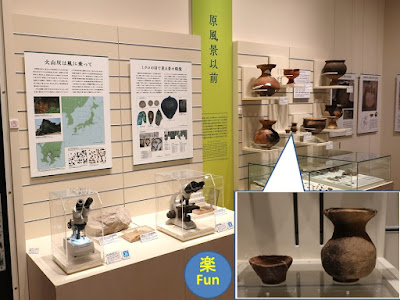Toshima ward of Tokyo is located at the north-west of Edo castle
which is the Imperial Palace now. A large entertainment district “Ikebukuro” is
in it, but it was a rural area in the Edo period (1603~1868). There were many flower and plant shops which were
broad, so they were similar to botanical gardens. They entertained Edo
people and tourists.
The area of this museum is equivalent
to two class rooms. We need to register before taking photos in the museum.
I introduce Jiyugakuen Myonichikan
which is a good old building near this museum, too.
Entrance
東京都豊島区は江戸城の北西、池袋を中心とする区だが、江戸時代は郊外の農業地域であった。巣鴨には、広大な植木屋があり、植物園として江戸の人々や旅人を楽しませていた。教室二つ分ぐらいの展示室である。写真は許可制になっている。
資料館の近くの自由学園明日館(重要文化財で相棒などのドラマのロケにも使われている)もご紹介。We walk in front of the chronology at first. The topics of people’s life are also written on it, for example, people prayed for pregnancy to the gingko tree of the Kishibojin Shrine in the early 19th century.
年表の前を通って展示室へ。政治だけでなく、鬼子母神の銀杏が文政年間(1818~1830)に子授け銀杏として流行したことなど人びとの生活が記されている。
Ancient Era、古代の展示
Small cup and pot (enlarged in the lower left) are polished and colored red. The caption says “Are these liquor sets of the ancient era?”.小型鉢(拡大写真右下側)は丁寧に磨かれて赤彩されており、「弥生時代の晩酌道具でしょうか」と書かれている。
Medieval Era、中世の展示
The primal landscape of Toshima was established then.豊島区の原風景が形成された時代と位置づけられている。
Edo period、江戸時代
Toshima transformed from agricultural
area to ciry. The census register of Zoushigaya, in which a famous shrine Kishibojin
is, shows that farmer’s population accounted for only 7% in 1818. Peddlers accounted
29% followed by teahouse workers, 16%. Kishibojin is a dignified shrine which
the Tokugawa shougun visited, therefore it gathered many visitors.
There
were many teahouses at the district and it was a nice one-day trip destination
for Edo people.
農村だった豊島区は、市街地に変わってくる。徳川将軍も参拝したという鬼子母神がある雑司ヶ谷の1818年の人別帳では、農民が占める割合は、わずか7%。時の物売が29%で一番多い。その次は、物見遊山や参詣の人を相手にした水茶屋で働いていた人が、16%だ。雑司ヶ谷は日帰り旅行先ですね。Kishibojin is popular even now which is the god of safety delivery and the guardian of children.
今の鬼子母神さん。安産・子安の神様である。
The candy shop in the ground started in 1781. I watch this shop on the TV show often. They sell good old snacks for children.
境内の駄菓子屋さん(1781年創業の上川口屋さん)は元々飴屋さんだったようだ。よくTVに出てくる。ポリボトルに入った駄菓子が懐かしい。
In the late 17th century, flower and plant shops in Somei had flourished. In the 18th century, they utilized broad land for visitors to walk around.
Ihei Ito, who was popular three hundred years ago, grew and sold plants. Moreover, he published the gardening book based on his experience of taking care of daimyo lords’ garden. Some travelers from northern Japan stopped over his garden when they visited Ise Shrine which is the most popular tourist spot.
17世紀の後半には、駒込村染井の植木屋が盛んになっていく。18世紀に入ると植木屋さん達は広い土地を利用し、見物客が自由に散策できるようにした。
3 00年前に活躍した伊藤伊兵衛は、植木の栽培・販売を行うだけでなく、大名庭園での経験を基に園芸書を出版した。東北から伊勢参りに向かう人たちが、伊兵衛の庭を訪れることもあったという。
Ito’s garden is depicted on the fryer for the azalea watching visitors. It is also explained on the screen, so I felt I walked around the garden. It is an enjoyable exhibit.
Ito also cultivated medical plants such as Korean ginseng. The shogunate (bakufu) gave him the precious seeds. The shougun also visited his garden, took a rest on the small hill and enjoyed the view.
伊兵衛の庭が詳細は、キリシマツツジが満開になる春に、花見客への宣伝用として作成されたと考えられる資料「武江染井翻紅軒霧島之図」に書かれている。スクリーンで丁寧に説明しており、庭を巡っているようで、楽しい展示だ。
観賞用だけでなく、幕府から種子を下賜された朝鮮人参などの薬草もあり、将軍(吉宗、家重)立ち寄った時の御腰掛場(見晴らしの良い小高い場所)もある。奥行き200mの広い庭である。
Chrysanthemum flower figure.
巣鴨の菊作り。通常の鉢植えから、様々な形をした菊を作っていく。
The gardeners made an elephant, a crane and Mt. Fuji by chrysanthemum flowers and entertained people. It was not enough entertainment at that time. I think it was a nice picnic destination for people, although the author of Kiyu-Shouran (Part 3) criticized that it was vulgar.
植木屋は、象、富士山、鶴などの形を菊で作り、人びと喜ばせた。嬉遊笑覧には「俗なる事甚し」と辛口に書かれているが(嬉遊笑覧 (Part 3))、娯楽が少なかった時代、良い物見遊山になったと思う。
British
botanist who visited Japan in 1860 was surprised with Somei and wrote “The whole country here is covered with nursery-gardens. One straight
road, more than a mile in length, is lined with them. I have never seen, in any
part of the world.” (F.Robert “Yedo and Peking (1863)”
Somei was great!
1860年に来日したイギリスの植物学者は「世界のどこへ行っても、こんなに大規模に、売り物の植物を栽培しているのをみたことがない」と記している。
染井は、すごかったんだ。
Btw, Somei-Yoshino is the most popular sakura cherry breed. In the late 19th century, gardeners in Somei diffused this breed as "Yoshino-sakura". However, people misunderstood it originated at Yoshino in Nara which is famous for its sakura. Therefore the name was changed to "Somei-Yoshino". I didn’t know this story.
The gardeners of Somei seemed to move to Omiya after the WW2. The Omiya Bonsai Art Museum, Saitama is in there, which is popular among foreign visitors.
染井の職人達は、戦後は、大宮に移っていったようだ。大宮盆栽美術館は、外国人に人気だ。
Modern Era、近代
Pass to a modern city and WWⅡ
明治・大正時代、そして第二次世界大戦
In the early 20th century, there were apartments with studios near Ikebukuro which was called “Nagasaki atelier village”. Young artists gathered there.
大正デモクラシーの時期のアトリエ付き貸家群・長崎アトリエ村の模型。若い芸術家達が集まったという。
After the WWⅡ, materials were not enough, so distribution was controlled by the government.
There was an illegal market in Ikebukuro at that time. The model is really elaborate.
戦後は、池袋に闇市が立った。こちらも精巧な模型だ。
Living and praying、「暮らす・祈り」のコーナー
Various old agricultural equipment is exhibited.様々な農機具が展示されている。
In this agricultural timetable, the changes in everyday life is written such as end of using a mosquito curtain. It’s interesting.
このパネルには、農作業と年中行事、自然の変化が書かれていて分かりやすい。
The museum has a reference space in which we can see documents and videos.
レファレンスルーム:資料や画像を閲覧できる。
The museum is seven minutes away from Ikebukuro station. It is in the seventh floor of this building.
池袋駅徒歩7分、としま産業振興プラザの7階に資料館がある。
Jiyugakuen Myonichikan、自由学園明日館
Frank Lloyd Wright (1867-1959),designed this girls’ school for Christians. I respected him when I was a student. This is less
than ten-minute walk from the museum.
The design is called “Prairie House”,
which emphasized the horizontal lines with reduced height.
学生時代に憧れていた建築家、フランクロイド・ライトのデザインした重要文化財だ。資料館から徒歩10分ぐらいのところにある。自由学園は、キリスト教系の女学校として創立された。
建物は、高さを抑えて水平線を強調した草原様式(プレーリー・スタイル)と呼ばれるらしい。
This meeting room was a classroom. It has a retro feel.
現在は会議室として使われている教室。趣がある。
A chapel was renovated to the café. Warm sunlight came into the room when I visited in winter. There are low chairs which were used in the classroom. The wedding ceremony is held in this room sometimes.
かつて礼拝をしていたホールは喫茶室に。暖かい陽が差し込んできます。椅子は、学校時代に使われていた低い椅子です。訪問時は、見学料400¥にプラス200¥でコーヒーと焼き菓子を頂けました。結婚式場としても使われています。
There is a fireplace at the opposite side of the window. Wright thought that people gather by the fire and make a communication space, so there are five fireplaces in this building.
窓の反対側には暖炉が。ライトは、「火のあるところには人は集まり、団欒の場を共有する」と考え、暖炉を設けたという。五カ所に暖炉がある。
Dining hall at the second floor、二階の食堂
There is a small Wright museum in the upper hall. He and his works are introduced. Photos of his masterpiece “Falling Water” (private house in Pennsylvania) are exhibited.
食堂から上がると「ミニ・ライト・ミュージアム」。ライトの足跡や、落水荘など代表作の写真があります。
The former classroom was used as the practice venue of a female chorus.
建物は女声合唱のレッスンにも使われていました。
Five funs(楽fun)were found. Visited in December, 2019
Website: http://www.city.toshima.lg.jp/129/bunka/bunka/shiryokan/kyodoshiryokan.html (in Japanese), accessed in June, 2020
Previous post (War time museum in Shinjuku):
Memorial Museum for Soldiers, Detainees in Siberia, and Postwar Repatriates、平和記念展示資料館
Next post (Museum in Toshima and Sugamo walking):





























Comments
Post a Comment